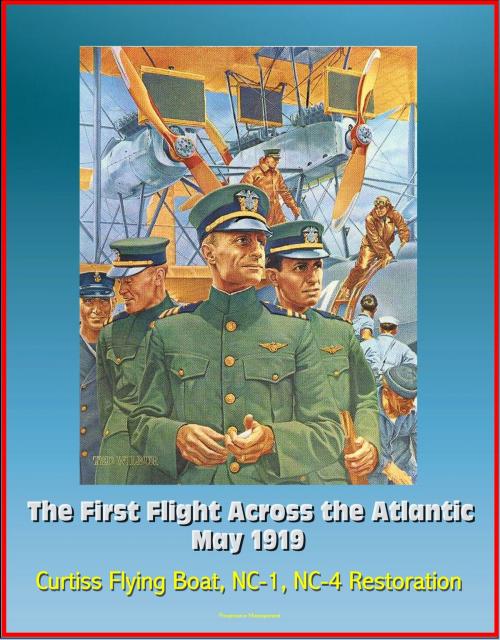The First Flight Across the Atlantic, May 1919: Curtiss Flying Boat, NC-1, NC-4 Restoration
Nonfiction, History, Military, Aviation| Author: | Progressive Management | ISBN: | 9781301736539 |
| Publisher: | Progressive Management | Publication: | January 29, 2013 |
| Imprint: | Smashwords Edition | Language: | English |
| Author: | Progressive Management |
| ISBN: | 9781301736539 |
| Publisher: | Progressive Management |
| Publication: | January 29, 2013 |
| Imprint: | Smashwords Edition |
| Language: | English |
A U.S. Navy crew and aircraft, backed by the entire Navy, won the honor of being the first to make the trip across the Atlantic in May 1919. The story of the NC-4's flight is a proud part of Naval Aviation and American history, retold in this history prepared on the 50th anniversary of the great event.
May 17, 1919, started off as a bleak day on the Islands of the Vultures. With classical whaling, Nantucket-style, one of their chief industries, the inhabitants of the Portuguese Azores were long accustomed to watching the sea. To this day, upon the lush green slopes and mountainsides are watchers' huts, shelters for the anxious eyes that seek a wispy spout. Poised below, among the rocks of black sand bights, whalers wait, boats and harpoons at the ready, eager for the signal that monsters are at hand. Now radio is used, but back then, once the telltale plume was spotted, fires were ignited in line with where the prey was seen to "blow."
But on that morning 50 years ago, there were no guiding lights; the mid-Atlantic pinnacles were misty with the shrouds of fog. Along rocky promontories, drizzle pierced low-lying clouds. A murky, thickening overcast had settled on the archipelago and, for a whale watcher, prospects of sighting blue-gray beasts were dim indeed.
Before noon, visibility on the island of Fayal was reduced to one or two miles. A west wind swept foggy blankets onto the southern shores, while turbulent air, spilling down from the mountains, created a sporadic breeze along the coast. There, on the Bay of Praia, shortly after 11:00 A.M., a strange sighting was made.
Observers on the beach said it started with a sound, a growing hum, a growling noise from seaward. As they peered toward Joao Diaz Point, suddenly from out of the gloom, slicing across the waters, came a huge gray shape: a whale-like body seemingly attached to burnished appendages that flickered dully in the half-light. Wallowing in an arcing turn, the "monster" barked, sputtered, then emitted a tremendous roar and, as quickly as it had appeared, faded away in a sound of thunder.
A U.S. Navy crew and aircraft, backed by the entire Navy, won the honor of being the first to make the trip across the Atlantic in May 1919. The story of the NC-4's flight is a proud part of Naval Aviation and American history, retold in this history prepared on the 50th anniversary of the great event.
May 17, 1919, started off as a bleak day on the Islands of the Vultures. With classical whaling, Nantucket-style, one of their chief industries, the inhabitants of the Portuguese Azores were long accustomed to watching the sea. To this day, upon the lush green slopes and mountainsides are watchers' huts, shelters for the anxious eyes that seek a wispy spout. Poised below, among the rocks of black sand bights, whalers wait, boats and harpoons at the ready, eager for the signal that monsters are at hand. Now radio is used, but back then, once the telltale plume was spotted, fires were ignited in line with where the prey was seen to "blow."
But on that morning 50 years ago, there were no guiding lights; the mid-Atlantic pinnacles were misty with the shrouds of fog. Along rocky promontories, drizzle pierced low-lying clouds. A murky, thickening overcast had settled on the archipelago and, for a whale watcher, prospects of sighting blue-gray beasts were dim indeed.
Before noon, visibility on the island of Fayal was reduced to one or two miles. A west wind swept foggy blankets onto the southern shores, while turbulent air, spilling down from the mountains, created a sporadic breeze along the coast. There, on the Bay of Praia, shortly after 11:00 A.M., a strange sighting was made.
Observers on the beach said it started with a sound, a growing hum, a growling noise from seaward. As they peered toward Joao Diaz Point, suddenly from out of the gloom, slicing across the waters, came a huge gray shape: a whale-like body seemingly attached to burnished appendages that flickered dully in the half-light. Wallowing in an arcing turn, the "monster" barked, sputtered, then emitted a tremendous roar and, as quickly as it had appeared, faded away in a sound of thunder.















